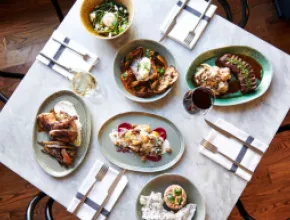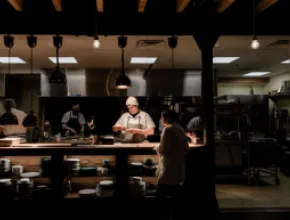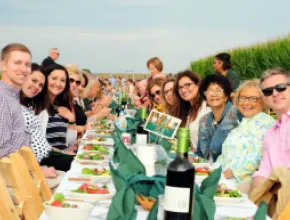Knowing a little history can go a long way toward understanding the Caribbean and its people. Instead of seeing one big beach, look again and you’ll see dozens of picturesque islands, each with its own unique cultural identity shaped by European colonists, African slaves and the timeless legacy of indigenous tribes.
The Bahamas
The Caribbean actually starts in the Atlantic, just off the coast of southeast Florida, where the 700 islands of the Bahamas begin their trek across 100,000 square miles of blue ocean waters. It was here where Columbus made his first landfall in the New World, and upon observing the shallow waters surrounding the islands, called the area baja mar (shallow sea).
However, Spanish influence in the Bahamas didn’t last; 200 years later, a major influx of American colonists still loyal to the British flag left the newly minted U.S. and landed on Bahamian shores, forcing the Spanish out and establishing the islands as a British colony.
Today, vestiges of colonial England remain throughout the Bahamas, from the architecture of Nassau to cricket season. Yet by far the greatest influence on the island nation came not from the loyalists themselves, but from their African slaves, who created the country’s singular sound—goombay—which means “rhythm” in the Bantu language of West Africa.
Dominican Republic
The Spanish came, and stayed, in the Dominican Republic, which is actually two-thirds of the island of Hispaniola, a name bestowed by Columbus during his first voyage to the New World. In fact, the entire island remained under Spanish control until 1697, when the western third became a French possession (now Haiti).
The island’s original inhabitants were the Taino Indians, whose customs were adopted by the Spanish though the indigenous tribes were eventually wiped out. Still, the influences remain, in the seafood dishes enjoyed by most Dominicans, in the fruits and vegetables they cultivate, in the tobacco they smoke, and even in the games they play. Today’s soccer is thought to have originated with the Tainos, who played batos, in which players could hit a ball with any part of the body except their hands.
A passion for song and dance was also part of the Taino culture, and that legacy is particularly strong in the Dominican Republic, where the national dance is merengue, which combines a mixture of African and European elements and is celebrated in major festivals throughout the year.
U.S. Virgin Islands
Following their discovery in 1493, the U.S. Virgin Islands changed hands again and again, as the English, Dutch, French, Spanish, Knights of Malta, and Danes all ruled at one time or another. During World War I, the U.S. finally bought the islands from Denmark for $25 million in gold.
Not surprisingly, many U.S. holidays—including President’s Day and the Fourth of July—are celebrated here, but with a distinctly tropical flair that includes calypso melodies and spirited dancing.
But this U.S. territory has its own long-standing traditions as well, left behind by the West African, Danish, Spanish, Irish, Polish, and German forbears who made the islands their home over the last five centuries. Calypso, reggae, soca, and salsa are all part of the cultural mix during events like the Three Kings Day festival on St. Croix and the annual Carnival on St. Thomas.
Jamaica
Like much of the Caribbean, Jamaica was originally settled by the Spanish, until the British came along, capturing the island in 1655 and driving the Spanish out; towns like Runaway Bay were named to commemorate the departure.
During the heyday of the British Empire, Jamaica became a marketplace of prosperity, with flowering and fruit trees brought from Asia, the Pacific and Africa; evergreens from Canada; roses from England; and sweet, dense breadfruit from Tahiti. But it is the African yam that gets its own weeklong festival every year.
Today, exotic fruits and spicy “jerk”-style meats are staples of Jamaican cuisine, along with East Indian and Chinese-influenced curries and noodles, basic British roasts and stews, and the national dish—ackee (a West African fruit) and saltfish, gently spiced.
If cuisine is Jamaica’s queen, reggae is the king. In fact, Bob Marley claimed the word was Spanish in origin, meaning “the king’s music.”
Jamaica’s premier musical art form is now celebrated in festivals throughout the year, including the annual Red Stripe Reggae Sumfest in July.
Puerto Rico
Like the Dominican Republic, Puerto Rico is steeped in the vestiges of colonial Spain, especially in the capital city of San Juan, where the El Morro fortress silently guards the entrance to San Juan Bay as it has for more than 450 years.
In fact, the island was a Spanish colony from 1493 to 1898, when it became part of the U.S. in the Treaty of Paris, ending the Spanish-American War. Still, those centuries under Spanish rule had a permanent effect on the language, religion, art, and architecture of Puerto Rico, while African and Indian influences also contributed to its vibrant national character.
The unique energy and spirit of Puerto Rico meet in its signature sound, salsa—literally, “sauce”—which encompasses many Afro-Latin sounds.
The literal “salsa” also infuses Puerto Rico’s unique cuisine, a tasty blend of Spanish, African, Taino, and American influences that utilizes indigenous ingredients.





